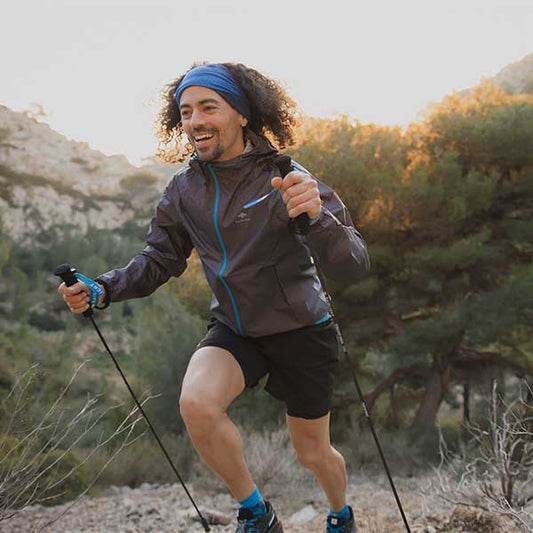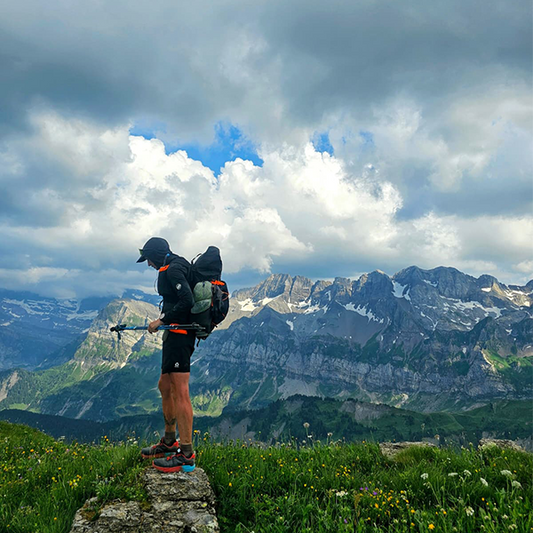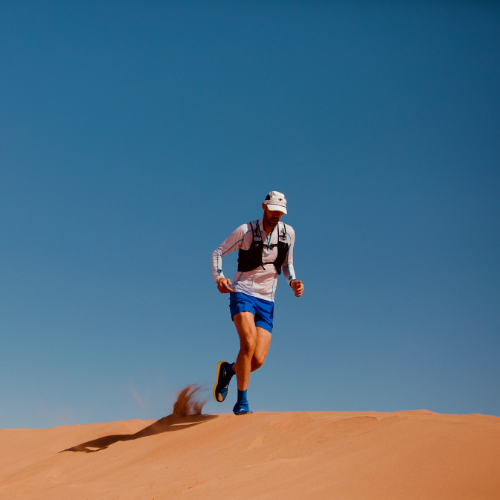« Which trail running shoes do I choose? » is THE question that every runner asks, whether they are a beginner or an experienced runner. Indeed, finding the most comfortable trail shoes possible, with a sole that grips on all terrains and in all conditions, is no easy task.
For trail running, it is essential to find the right pair of trail shoes for your needs. It's no secret that a trail run with unsuitable trail shoes can turn into a real nightmare.
Several criteria should be taken into account: weight, comfort, cushioning*, fit, drop*, terrain, size and training frequency.

Before buying your trail shoes, it is important to answer three questions:
- What is the objective?
If you are a beginner, choose a pair that is versatile, light and above all very comfortable.
If you are a regular runner, favour support and reinforced shoes.
For racing, choose lightweight, precise and dynamic trail shoes to optimise performance.
- For which distance?
Short distance (less than 20km) : Choose a light and responsive trail shoe like the dynamic 2.0 which will provide the necessary grip while maintaining good performance. The thin soles will provide more lightness.
Medium distance (from 20 to 50km) : Choose a versatile trail shoe like the Revolutiv 3.0 which combines support, thanks to its neoprene liner, with dynamism and grip thanks to its 6mm studs.
Long distance and ultra trail (+ 50km) : prefer reinforced trail shoes with lots of cushioning* to reduce fatigue and increase comfort. The Ultra 3.0 trail shoe has been designed to offer the perfect mix of comfort, grip and performance.
Whatever the distance, choose a model that is as comfortable as possible, your foot should be well supported (in particular to avoid discomfort on the way down), not too tight, with no rubbing areas.
- On what types of terrain?
It is important that your shoe has the right grip for the trails you are training and competing on.
Muddy ground: Grip will be very important, so look for trail shoes with large lugs such as the Revolutiv 3.0 which has 6mm lugs that will give you a great grip.
Snow: Enhance grip with extra protection from the elements. Pair your trail shoes with trail gaiters for added comfort and protection from the snow.
Mixed ground : Choose a light, versatile and flexible pair to facilitate the rolling of the foot. 4mm studs are sufficient to provide grip.
Rocky mountain terrain: The Revolutiv 3.0 trail shoe is ideal for the toughest mountainous terrain. The Revolutiv 3.0 trail shoe is ideal for tackling the toughest mountain terrain.

Regardless of your trail shoes, we recommend that you choose waterproof trail socks. Depending on the season and location, waterproof effectiveness is a factor that can be important if you plan to run in wet or unstable weather. At Raidlight, we've taken it upon ourselves to design waterproof socks to stay dry in all conditions. In addition, having waterproof socks allows good breathability and prevents moisture from settling in.
In trail running (as in road running) it is advisable to choose a pair of shoes where the size is one size larger than your basic size. If you are a size 44, then you should choose a size 45. You should also take into account your body type, if you are a large person, choose a trail shoe with more cushioning for more comfort. If you are a lightweight, choose a lighter pair..
Advice from our Research and Development Manager: « In trail running, the terrain is uneven and so is the support. A trail shoe must therefore offer stability and grip to adapt to all types of terrain. In addition, trail running is often done on aggressive trails, so it is important that the shoe is reinforced to protect and reduce the impact of stones on the foot and toes. Finally, the more the top of the foot is supported, the less rotation of the foot on unstable terrain will be possible, thus increasing the precision and efficiency of the stride. »
*Drop: The drop of a shoe is the difference in height between the heel and the forefoot. The greater the drop, the greater the slope between the heel and the forefoot.
*Cushioning: When you run, you produce energy. When you hit the ground, the sole of your shoe absorbs some of this energy and dissipates it, instead of sending it back to your bones, muscles and joints.












2 comments
Bonjour
Je souhaite acheter une paire de ultra 3. Pour la taille m, sachant qu en chaussure de ville je chausse du 42.5 faut il du 43 ou 44 (s agissant de chaussures trail)? Chaussent ils petit?
Merci
Bonjour je cours actuellement depuis environ un voir deux ans avec des saucony 13 ou 12 quelles sont les chaussures les mieux adaptées à mon physique je mesure 1:63